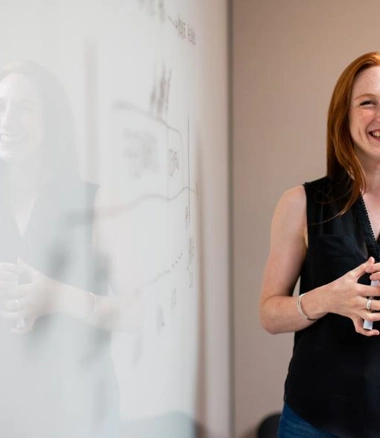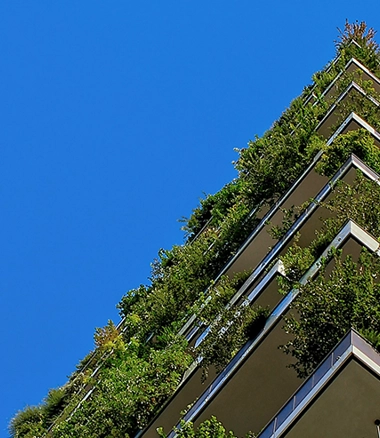
As specialist recruiters in the ever-evolving field of building services engineering, we are keenly aware of the importance of sustainability in the industry. With a growing global focus on environmental responsibility, it is imperative that professionals like yourselves embrace sustainability as a core principle in their work. In fact, our recent salary guide survey reveals that 56% of surveyed organisations in the sector prioritise sustainable and environment-positive practices, albeit with room for improvement as 38% are yet to make sustainability a top priority.
In this blog, we will delve into five compelling ways sustainability can drive innovation in building services engineering and how embracing these opportunities can not only benefit the environment but also help revolutionise the industry.
Redefining Design Paradigms
Traditional building design often neglects sustainability in favour of immediate cost savings or aesthetic appeal. In the face of rising material costs, engineering firms are under increasing pressure to deliver profitable projects. However, incorporating sustainable practices into building services engineering does not need to be an additional expense and can open up new avenues for innovation. By harnessing the power of renewable energy sources, such as solar and wind, engineers can design buildings that generate their own energy, reducing reliance on fossil fuels and grid energy. Integrating advanced technologies like smart grid systems and energy-efficient lighting can further optimise energy usage, resulting in reduced operating costs for building owners while mitigating environmental impact.
Sustainability is not just about reducing the negative environmental impact of buildings; it is about reimagining the way we approach design and construction. By integrating sustainable design principles, engineers have the opportunity to push the boundaries of innovation. For example, incorporating passive design strategies such as natural ventilation and daylight harvesting can reduce the reliance on mechanical systems, leading to energy-efficient buildings that minimise operational costs. The challenge lies in identifying creative solutions that optimise both energy performance and occupant comfort.
Maximising Resource Efficiency
The scarcity of natural resources necessitates a paradigm shift towards resource-efficient buildings. Sustainable building services engineering promotes the effective use of resources through innovative design and technologies. For instance, the adoption of rainwater harvesting systems and grey water recycling allows for the efficient use of water resources, reducing strain on municipal supplies and lowering water bills for building owners. Similarly, intelligent mechanical engineering and the design of smart HVAC (Heating, Ventilation, and Air Conditioning) systems can optimise energy consumption by adjusting cooling and heating based on real-time occupancy, thereby minimising waste.
The adoption of renewable energy sources presents an exciting avenue for innovation in building services engineering. Solar panels, wind turbines, and geothermal systems are becoming increasingly affordable and accessible, allowing engineers to integrate these technologies into building designs. The integration of energy storage systems, such as advanced batteries, enables buildings to store excess energy generated during peak production periods for later use. This interplay between renewable energy sources and storage systems represents a paradigm shift in the way we think about energy supply and demand.
Life Cycle Assessment and Circular Economy
Sustainability in building services engineering extends beyond the initial construction phase. It encompasses the entire lifecycle of a building, including its operation, maintenance, and eventual decommissioning. By considering the full lifecycle, engineers can identify opportunities for improvement and innovation. Conducting life cycle assessments enables the evaluation of environmental impacts and the identification of areas for optimization. Furthermore, embracing the principles of the circular economy promotes resource efficiency and waste reduction. For example, designing buildings with modular components allows for easy disassembly and reusability, reducing waste and extending the lifespan of materials.
Leveraging Technological Advances
The advent of advanced technologies has revolutionised the field of building services engineering. Smart building management systems, equipped with sensors, analytics, and automation capabilities, offer a multitude of opportunities for sustainability and innovation. The Internet of Things (IoT) can be harnessed to collect real-time data on energy consumption, occupancy patterns, and indoor air quality, facilitating continuous monitoring and optimization, providing real-time feedback to facility managers, and enabling proactive decision-making. For instance, real-time occupancy sensing can adjust lighting and HVAC systems based on actual demand, reducing energy waste.
In addition, Building Information Modeling (BIM) software, for example, enables the creation of digital models that simulate energy usage, daylighting, and ventilation, allowing engineers to optimise building performance before construction even begins. Moreover, These advancements not only improve sustainability but also enhance overall building performance, occupant comfort, and operational efficiency. By leveraging these intelligent systems, engineers can create buildings that are not only efficient but also adaptable to changing needs and contexts.
Collaboration and Knowledge Sharing
Sustainability requires a collaborative effort that goes beyond the boundaries of traditional engineering disciplines. Building services engineers need to work closely with architects, urban planners, environmental consultants, and other stakeholders to achieve holistic and innovative solutions. Embracing a multi-disciplinary approach fosters the exchange of ideas, promotes creativity, and challenges conventional thinking. By collaborating with experts from diverse fields, engineers can leverage their collective knowledge to push the boundaries of sustainable building design. Organisations and industry associations such as CIBSE foster a culture of knowledge exchange through conferences, workshops, and online platforms. Collaborative partnerships can also spark creativity and push boundaries, resulting in groundbreaking solutions to sustainability challenges.
As a recruiter in the building services industry, we encourage you to embrace sustainability as a driving force for innovation. As consulting and engineering firms continue to prioritise sustainability, demonstrating an understanding of sustainable design principles and how they can be applied in your work to achieve greener buildings that positively impact occupants and the environment are becoming increasingly important skills. By integrating sustainable design principles, leveraging renewable energy sources, adopting intelligent building management systems, considering the entire lifecycle of a building, and fostering a collaborative approach, you can play a pivotal role in shaping the future of building services engineering. Moreover, it can help you stand out in an industry increasingly embracing sustainable design.
The opportunities to create a path towards a sustainable future are boundless. If you are seeking new career opportunities in environmental engineering, esd or sustainable building design we would love to hear from you.





